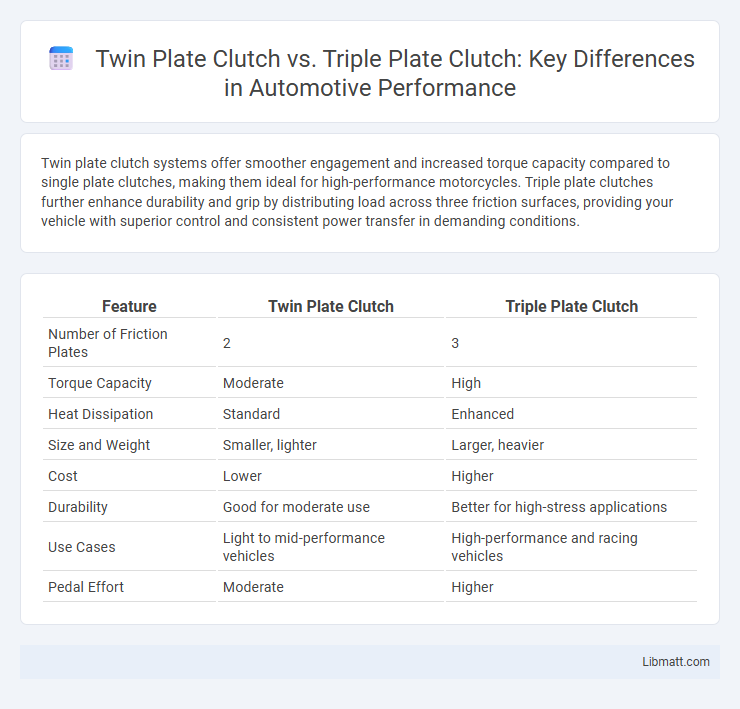Twin plate clutch systems offer smoother engagement and increased torque capacity compared to single plate clutches, making them ideal for high-performance motorcycles. Triple plate clutches further enhance durability and grip by distributing load across three friction surfaces, providing your vehicle with superior control and consistent power transfer in demanding conditions.
Table of Comparison
| Feature | Twin Plate Clutch | Triple Plate Clutch |
|---|---|---|
| Number of Friction Plates | 2 | 3 |
| Torque Capacity | Moderate | High |
| Heat Dissipation | Standard | Enhanced |
| Size and Weight | Smaller, lighter | Larger, heavier |
| Cost | Lower | Higher |
| Durability | Good for moderate use | Better for high-stress applications |
| Use Cases | Light to mid-performance vehicles | High-performance and racing vehicles |
| Pedal Effort | Moderate | Higher |
Introduction to Multi-Plate Clutches
Multi-plate clutches use several friction plates to increase torque capacity and improve heat dissipation compared to single-plate designs. Twin plate clutches typically balance compact size with moderate torque handling, commonly found in motorcycles and performance cars. Triple plate clutches add an extra friction surface, enhancing torque capacity and durability for high-performance or heavy-duty applications.
Overview: Twin Plate Clutch
A Twin Plate Clutch features two friction discs, offering increased surface area and improved torque capacity compared to single plate clutches, making it ideal for high-performance motorcycles and racing applications. It provides smoother engagement and better heat dissipation, enhancing durability and rider control during aggressive acceleration. Your choice of a twin plate clutch can significantly boost vehicle response while maintaining manageable weight and compact design.
Overview: Triple Plate Clutch
Triple plate clutches feature three friction plates, offering increased surface area for better torque handling compared to twin plate clutches. This design enhances performance in high-power motorcycles and racing vehicles, providing smoother engagement and improved heat dissipation. The triple plate clutch system is ideal for riders seeking superior control and durability under demanding conditions.
Key Differences Between Twin and Triple Plate Clutches
Twin plate clutches offer improved torque capacity and smoother engagement compared to single plate versions, while triple plate clutches provide even greater torque handling and heat dissipation due to the additional friction surface. The increased number of friction plates in triple plate clutches results in higher clamping force and durability, making them ideal for high-performance and heavy-duty applications. However, triple plate clutches tend to be heavier and more complex, potentially affecting pedal effort and maintenance compared to twin plate designs.
Performance Comparison: Twin vs Triple Plate
Twin plate clutches offer quicker engagement and lighter pedal effort, making them ideal for daily driving and moderate performance applications, while triple plate clutches provide increased torque capacity and heat dissipation for high-performance racing and heavy-duty use. The additional friction surface in triple plate clutches enhances durability and grip, enabling better handling of power in motorsports or aggressive driving conditions. Twin plate clutches balance efficiency and durability, whereas triple plate clutches prioritize maximum performance and robustness under extreme stress.
Durability and Longevity
Twin Plate Clutches offer improved durability over single plate designs by distributing load across two friction plates, enhancing heat dissipation and wear resistance. Triple Plate Clutches further increase longevity by incorporating an additional friction surface, providing superior torque capacity and reducing stress on individual components during high-performance use. Your choice between twin and triple plate clutches should consider operational demands, as triple plate systems excel in endurance for heavy-duty or racing applications.
Driving Experience and Pedal Feel
Twin Plate Clutches offer smoother engagement with lighter pedal effort, enhancing everyday driving comfort and ease in traffic conditions. Triple Plate Clutches provide increased grip and durability, delivering a more aggressive pedal feel suited for high-performance driving and rapid power transfer. Choosing the right clutch can significantly impact your vehicle's responsiveness and overall driving experience.
Cost and Maintenance Considerations
Twin plate clutches typically offer a balance between cost and performance, featuring lower initial expenses and simpler maintenance compared to triple plate clutches. Triple plate clutches, while more expensive and complex, provide enhanced durability and heat dissipation, making them suitable for high-performance or heavy-duty applications that justify the higher upkeep costs. Your choice depends on whether you prioritize budget-friendly maintenance or advanced performance capabilities in demanding driving conditions.
Best Applications for Twin vs Triple Plate Clutches
Twin plate clutches excel in high-performance street vehicles and moderate racing applications due to their balance of durability and smooth engagement. Triple plate clutches are best suited for extreme racing conditions and heavy-duty motorcycles where maximum torque capacity and heat dissipation are critical. Your choice depends on whether you prioritize smoother daily driving (twin plate) or maximum power handling in competitive environments (triple plate).
Choosing the Right Clutch for Your Vehicle
Selecting the right clutch depends on your vehicle's power output and intended use, with twin plate clutches offering smoother engagement and better torque handling for performance street cars. Triple plate clutches provide increased surface area, allowing higher torque capacity and improved heat dissipation, making them ideal for high-powered race or off-road vehicles. Consider factors like engine horsepower, driving conditions, and pedal feel to determine the optimal clutch system that balances durability and drivability.
Twin Plate Clutch vs Triple Plate Clutch Infographic

 libmatt.com
libmatt.com